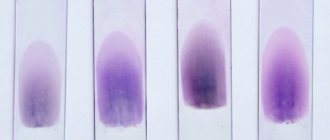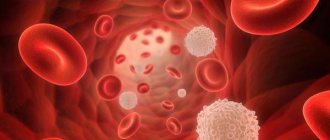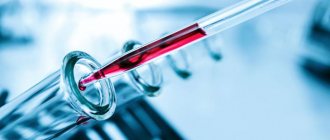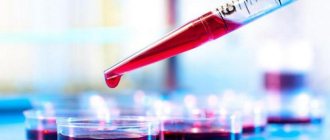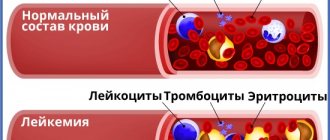Humanity realized the danger posed by the human immunodeficiency virus (HIV) too late.
The disease it causes is acquired immunodeficiency syndrome (AIDS).
True, at the beginning of the 21st century, doctors have learned to effectively fight this infection.
No one will deny that the leading role in this direction was played by the improvement of laboratory methods for detecting infection.
As well as studies of blood parameters of already infected people.
Changes that can be detected in biochemistry
If blood biochemistry is done for HIV, its indicators must be assessed with extreme caution, as doctors note.
After all, changes can indicate both the presence of an infection in the body and some other diseases. It is also important to take into account that during the latent period the indicators remain completely normal. Doctors identify a number of indicators that can indirectly indicate an infectious process
These include:
Often patients do not understand why potassium levels in the blood increase. The fact is that HIV often affects the kidneys, and in its acute phase it can provoke diarrhea and vomiting in patients. This is what helps improve performance.
If the liver or kidneys are involved in the pathological process, the amount of albumin proteins in the circulatory system can increase significantly.
Glucose is associated with diabetes in many hospital patients.
However, it also increases with HIV, if the virus has already infected the liver. It is recommended not to forget that the results of blood biochemistry do not diagnose infection with the virus. To make a final diagnosis, a number of additional tests are necessary.
Anemia in liver cirrhosis
The appearance of anemia in liver cirrhosis is considered common. Anemia is caused by various factors that are directly related to problems of the liver or endocrine system. Elimination of anemia and therapeutic measures are carried out only in the treatment of the underlying disease that provoked the development of anemia.
Microcytic anemia is often observed, which is caused by the following factors: chronic inflammation of the liver leads to portal hypertension, cases of venous bleeding occur in the liver, esophagus and stomach. The disease also leads to problems in the metabolic process of folic acid and vital vitamin B12 - all these reasons cause a drop in hemoglobin in the blood.
Immune status for HIV indicators
With HIV infection, immunity levels are primarily affected.
In the acute phase of the disease, there is a sharp decrease in the level of CD4 lymphocytes. Then, after viremia decreases, the number of these cells begins to gradually recover.
However, without antiretroviral therapy it will never reach baseline levels. A week after infection, a cascade of cytokine reactions is launched. There is a significant increase in the amount of cytokines in the blood. They help keep the infection under control.
During the same period, the number of CD8 T lymphocytes increases. They play a major role in controlling infection. Namely, they kill cells affected by HIV using cytolysis. They also act indirectly, by increasing the production of cytokines.
During the period of increase in the CD8 lymphocyte population, there is a primary decrease in the viral load. T cells are capable of destroying the virus. But it mutates quite quickly, protecting itself from the immune system. In the future, an immunogram for diagnosing HIV becomes uninformative. Because the indicators are approaching normal values.
If there are deviations from the norm, they are insignificant. The total CD4 count usually decreases.
The CD8 lymphocyte count may be elevated. The CD4/CD8 ratio decreases.
With HIV it is less than one. After a few years, the stage of severe immunodeficiency (AIDS) begins.
In this case, the number of CD4 in the blood sharply decreases. On average, a healthy person has 800 to 1050 per µl. The norm is considered to be a CD4 blood level of 500 to 1600 per µl.
With HIV, their number can decrease to 200 per µl or less. The total number of T-lymphocytes decreases to 1000 or less per μl.
The CD8 count remains within normal limits. Therefore, the CD4/CD8 ratio decreases significantly. Normally it is 0.9-1.9. That is, there should be one and a half to two times more CD4 lymphocytes than CD8. But with HIV there are significantly fewer of them.
Antiretroviral therapy is usually started when the CD4 count is below 350/mm3.
Another indicator may also be used to determine the level of HIV immunodeficiency. This is the percentage of CD4 in the total number of T lymphocytes. The critical value is 15%. This means that aggressive antiretroviral therapy should be started. Including in the case when the total number of CD4 in the immunogram remains high.
There is a direct relationship between viral load and CD4 levels in the blood. On average, a person has about 1000 of these cells per ml at the time of infection.
At the peak of the acute phase of HIV, when the viral load is highest, the CD4 count drops to 500 per microliter or less. This occurs on average 6 weeks after infection. Then, over the next 9-12 months, a gradual increase in CD4 begins.
It reaches a value of 600-700 cells per ml. But then it starts to go down again.
The decline in CD4 levels occurs slowly but steadily. On average, 5 years after the onset of the disease, their level is below 400 per µl. After 7 years there are already less than 200 of them per µl.
The number of these cells can predict various opportunistic diseases. In prognostic terms, the dynamics of changes in the CD4 count are important.
The high-risk group includes patients whose number of these cells decreases by 100 or more per microliter in 6 months. If their number decreases by 20-50 cells per µl over a year, this is an average risk.
What does the general analysis show?
Mainly, a clinical blood test is carried out to find out the following indicators:
- Level of hemoglobin - iron-containing protein;
- The number of erythrocytes - red blood cells;
- Color indicator - the level of relative hemoglobin content in one red blood cell;
- The number of leukocytes - red blood cells;
- The number of platelets - non-nucleated cells responsible for blood clotting and the formation of an aggregate for blocking a damaged vessel;
- Erythrocyte sedimentation rate is the ratio of protein fractions in plasma.
With the development of technologies for hardware blood analysis, the color indicator has lost its practical significance due to this. Which gives a less accurate idea of the hemoglobin content than the analyzer. But it is still carried out under microscopic examination. During a clinical blood test, other indicators may be determined.
An increase in hemoglobin levels may indicate dehydration of the body, intoxication with combustion products of tobacco (with excessive smoking, especially active smoking), or a benign tumor lesion of the blood system. A decrease in hemoglobin levels is observed with anemia or anemia, as well as with overhydration, that is, an increase in plasma volume.
An increase in the number of red blood cells indicates possible neoplasms, hydrocele (accumulation of transudate) of the renal pelvis, hypercortisolism syndrome, and also occurs during treatment with steroids or corticosteroids. Due to some conditions - burns, diarrhea, taking drugs with a diuretic effect - the blood can thicken, then a clinical analysis reveals an increase in the number of red blood cells.
A decrease in the number of red blood cells occurs with anemia, accelerated destruction and a decrease in the intensity of their formation in the bone marrow. Also, a slight decrease in red blood cells is observed in pregnant women, as well as during uterine bleeding (like Ebola fever) of various etiologies. Blood loss for various reasons (trauma, surgery, donation) before restoration of normal blood volume also appears in the test results.
Red blood cells are found in smaller quantities during diuretic or infusion therapy and for some time after them. A decrease in the color index indicates the likelihood of iron deficiency or anemia caused by lead intoxication. An increase in the color index can be observed with a deficiency of folic acid and vitamin B12, gastric polyps and cancer. Changes in the level of leukocytes indicate much more serious and even dangerous health problems.
An increase in their level occurs during acute inflammation in various organs and tissues, sepsis and other purulent processes. Infectious invasion of the body, tissue trauma, myocardial infarction, malignant tumor processes. A slight increase in the number of leukocytes is observed in pregnant women and women who have recently given birth, and in breastfeeding mothers. And also in athletes during active training and in people engaged in heavy physical labor after significant muscle strain.
A decrease in the number of leukocytes occurs with a rare hereditary disorder - achondroplasia, as well as with radiation sickness, typhoid fever, megaloblastic anemia, rheumatic diseases, leukemia, myelofibrosis, plasmacytoma, salmonella infection.
Anaphylactic shock, recently suffered by the patient, also leads to a change in the blood formula. Elevated platelet levels are observed in patients:
- with essential thrombocythemia;
- with a tendency to thrombosis.
A reduced level of platelets is observed in cancer, malaria, and bronchial asthma.
The erythrocyte sedimentation rate increases in oncology, anemia of various natures, collagenosis, and infectious diseases. Accompanied by inflammation, after bone fractures, operations, as well as in women during menstruation, pregnancy, and the postpartum period. The erythrocyte sedimentation rate decreases with jaundice, increased levels of bile acids, and circulatory failure.
Any deviations of the clinical blood test parameters from the norm require repeated sampling. If the repeated analysis duplicates previous results, then additional studies must be prescribed:
- blood chemistry;
- analysis to identify individual pathogens (Wassermann reaction, determination of antibody titer to various infections);
- glucose tolerance test;
- thromboelastography;
- thrombodynamic test;
- pulse oximetry;
- coagulological tests.
ESR indicator for HIV
ESR is an indicator that increases during inflammatory reactions in the body.
Normally, it should not exceed 10 mm/h.
With recent HIV infection, this rate can increase significantly. Then he gradually returns to normal.
ESR reflects the activity of the immune system. This indicator corresponds to the level of cytokines. Including interleukin-6 and tumor necrosis factor α. In the future, an increase in the level of ESR can suggest an increase in the activity of HIV infection. Because this indicator increases during the period when there is a decrease in the number of CD4 cells.
But in practice, ESR is not of great importance in diagnosis. Because all patients have their CD4 leukocyte count regularly determined. Their numbers are checked every few months.
ESR is not a marker of acute intercurrent pathologies in HIV. Often, even a significant increase in the rate of up to 100 mm per hour or more is not accompanied by any infections or symptoms.
Which leukocytes are most affected by HIV?
The immunodeficiency virus, affecting immune cells, interferes with their work, and over time they cease to perform their functions. As a result of these processes, the body cannot fight infections and slowly dies. HIV attacks those protective cells that have CD-4 protein receptors on their surface. A large number of them are contained in the membrane of helper T-lymphocytes. Thanks to the activation of other lymphocyte cells, they significantly enhance the response to the penetration of infectious agents into the body. In addition, CD-4 contains macrophages, monocytes, Langerhans cells and others.
Initially, you can suspect the presence of the immunodeficiency virus by deciphering the results of the CBC (complete blood count). In the early stages of HIV, white blood cells are elevated. With progression, neutropenia (decreased neutrophils) and lymphopenia (decreased lymphocytes) are observed and, as a consequence, weakened immunity. Of course, a general blood test is not specific. At different stages of the disease, white blood cells can be either higher or lower than acceptable values.
How to take a general blood test
The procedure for donating blood to analyze basic indicators will not cause the patient much discomfort. Blood is usually taken from the ring finger. If it is necessary to identify a larger range of indicators, the sample is taken from a vein.
For regular blood sampling, the finger of the left hand is wiped with a swab or cotton wool soaked in alcohol, and then a small puncture is made using a special small needle. At this point, blood begins to appear, which is collected using a special pipette. Part of this blood is immediately placed in a test tube, and part is placed on a laboratory glass.
Venous blood is donated for analysis from the area of the forearm where the veins are best visible. In this case, the area above the elbow bend is tightened with a medical tourniquet, and the patient is asked to clench his fist tightly several times so that blood flows to the arm.
Blood is drawn using a needle and a special flask. The procedure is painless, but it all depends on individual sensitivity. The maximum you will feel is the discomfort from the skin being punctured, nothing more.
After that, you just have to wait for the results to come. Usually, they can be picked up from the clinic the next day.
You can find out the interpretation of the results obtained from your attending physician, who knows exactly what the norm is for certain indicators. You can also decipher your results yourself - just find data regarding each item on the Internet.
Typically, this is a large summary table in which indicators are divided into groups based on gender and age. Of course, you shouldn’t check the first table you come across, because, as you know, not all information presented on the Internet is true.
We recommend trusting trusted sites that belong to large clinics or laboratories. They, first of all, specialize in such topics, and secondly, they care about their reputation. Therefore, obviously unverified information will not be published.
How to eliminate the possibility of obtaining a false research result
To prevent receiving an erroneous or questionable HIV test result, the following rules must be followed:
- Take venous or capillary blood in the morning from 7.00 to 10.00.
- The day before blood collection, you should not eat for 8 hours. The results of the study will change due to the patient's consumption of fatty, spicy, fried foods.
- 1-2 days before the examination, eliminate alcohol from your diet.
- For infectious and inflammatory diseases, refrain from donating blood for testing until complete recovery.
- Before the examination, tell your doctor about the medications you are taking. Take the test no earlier than 10 days after stopping antibiotics.
- Increased physical activity or stress on the eve of the test can also lead to false positive results.
If the doctor has doubts about the results of the examination, he can refer the person to take the test again, warning him about the need to exclude negatively influencing factors.
News on HIV infection blood test
Read more
AIDS really does not sleep: in the USA there is a new scandal with HIV infection among porn actors
After HIV infection was discovered in one of the porn stars in August, US film studios specializing in the filming of XXX films worked as usual for only a few days. And yesterday it turned out that a male actor was also infected with a dangerous virus.
Read more
Testing for HIV infection in 20 minutes using saliva test
Existing methods of analysis for the presence of the immunodeficiency virus in the body are based on examining a blood sample; in addition, such an analysis requires a lot of time. The method of testing for HIV using saliva analysis does not have these disadvantages.
Read more
Charlie Sheen tried to be cured of HIV infection by... a “witch doctor”
Recently, American film actor Charlie Sheen, well known to our movie fans, admitted that he is infected with the immunodeficiency virus. Sheen's reappearance in the television studio was accompanied by a dramatic story about his attempts to get rid of HIV.
Read more
Why finger prick blood test results may be inaccurate
The accuracy of modern laboratory equipment allows in many cases to avoid taking blood for analysis from a vein and limit yourself to 1-2 drops of blood obtained from a finger. But scientists say that there should be at least 6 or even 9 “droplets”.
Read more
Residents of France have the opportunity to be tested for HIV infection at home
France has become the latest European Union country to offer special kits for self-diagnosis of the human immunodeficiency virus in its pharmacies. This measure will make it possible to additionally identify hundreds of HIV-infected people every year.
Read more
Monstrous negligence - with one needle a blood test was taken from 53 cancer patients
Because of a mistake by a clueless nurse, 53 Australians will be waiting in suspense for the next few months. The technical ignorance of the medical worker led to the fact that for 2 months the needle in a special device for automatic blood sampling was not changed, which is supposed to be changed after each test. For the 53 people who passed through the “caring” hands of the laboratory assistant over these two months, such a mistake is fraught with infection with the most serious illnesses. The situation is aggravated by the fact that all the victims are patients at an oncology clinic...
Read more
Pocket laboratory will determine HIV infection and much more
The importance of obtaining test results as quickly as possible, especially when an infectious disease is suspected, cannot be overestimated - therefore, the invention of the Colombian engineer will undoubtedly arouse interest not only among doctors, but also among manufacturers of medical equipment. A small device, the size of a cell phone, can accurately determine from a drop of blood taken from a patient the presence of infection in the body, including sexually transmitted diseases, as well as prostate cancer.
Read more
HIV-infected French woman has not taken medication for 12 years - and is completely healthy
More and more scientists are inclined to think that complete victory over AIDS will become possible when it is possible to mobilize the immune system of patients to fight HIV. Indirect evidence of their correctness can be the medical history of a young French woman.
Read more
HIV self-diagnosis kits are a “hit” of the spring season
At the end of April, an unusual new product appeared in pharmacies in the United Kingdom - kits for performing a blood test for HIV infection at home. The test is highly accurate and is officially certified.
Decoding the results
Interpretation of a clinical blood test is carried out only by the attending physician. A deviation of any of the indicators, up or down, has diagnostic significance. During viral invasion, almost all venous blood values change. Changes in the general analysis of venous blood in the presence of HIV depend on the stage of the disease and the presence of a secondary infection.
The most important is the interpretation of the leukogram - the total number of leukocytes and their subclasses, the number of monocytes and lymphocytes. In most cases, the structure of the white blood cell changes - various forms of leukocytes and lymphocytes. This is due to the direct influence of the immunodeficiency virus on the cells of the immune system. Leukocytes try to protect the body from viral invasion, as a result of which it begins to actively release them from physiological depots. Therefore, in the early phase of the disease, their pathological increase in the peripheral blood is possible - leukocytosis. Lymphocytes become the main target for the pathogen. Penetrating into lymphocytes, the retrovirus leads to their death. This clinical syndrome is called lymphopenia.
Changes in the level of red blood cells and platelets are considered secondary. These indications are not specific and indicate the presence of a severe infectious reaction of any etiology. The indicator ESR (erythrocyte sedimentation rate) is clinically important. It detects inflammation, autoimmune reaction or infectious invasion.
Any changes require a detailed analysis for HIV infection. It is worth remembering that the normal blood flow test data also depend on the patient’s age. For children, the values change with each year of life. Stabilization of indicators occurs at approximately 13 years, after which peripheral blood readings become the same for patients of any age. In addition, there are gender differences in the cellular composition of the blood.
Table of normal hemogram indicators for a healthy patient
Changes in white blood cell count
White blood cells are a direct reflection of the state of the body's immune system.
Depending on the stage of disease progression, white blood cell values may be increased or decreased. An extremely low concentration of white blood cells in the bloodstream indicates the terminal stages of the disease. Changes in the level of leukocytes begin already at the first stage of the disease. In response to the penetration of the pathogen into the body, a protective reaction is launched, which is aimed at eliminating the pathogen from the bloodstream. Leukocytes are the first to encounter infection, so in the early stages of the disease there is an increase in them - leukocytosis.
The degree of leukocytosis depends on the severity of the inflammatory reaction: the stronger it is, the greater the expression of the shift in the leukocyte formula. A shift in the leukocyte formula is understood as an increase in the number of young granular forms that leave the depot due to increased leukocyte hematopoiesis. Leukocytosis is also characteristic of secondary infections against the background of acquired immunodeficiency.
In the terminal stages of the disease, the patient’s immune resistance sharply weakens, so even with strong viral or bacterial invasions, there is no adequate response of the immune system to the pathogen. In this case, leukocytes in HIV are significantly lower than normal.
Changes in lymphocyte levels
A typical indicator of HIV positive status is damage to lymphoid tissue and cells.
The number of lymphocytes during the incubation period is increased. Then the retrovirus has a detrimental effect on the T-cell link, leading to its sharp depletion due to cell death. Clinically, this is manifested by lymphopenia - a decrease in the number of agranulocytes below normal. Lymphopenia progresses along with the disease, being its laboratory reflection. In the early stages of immunodeficiency, the number of lymphocyte cells may be normal or slightly increased. Significant lymphopenia indicates that the patient’s disease has been ongoing for a long time. In the terminal stages (AIDS), a laboratory diagnostic doctor may not even detect a single lymphocyte in the field of view.
Platelets in HIV
About half of HIV-positive patients have a decreased platelet count in their blood tests. These cells ensure normal blood clotting and primary hemostasis through aggregation among themselves and subsequent clot formation. Clinically, thrombocytopenia in a blood test is manifested by small hemorrhages in the form of spots and rashes on the skin or mucous membranes. A significant decrease in platelet concentration is characterized by prolonged bleeding. Even with minor injuries, painful hematomas can form in the muscles or under the fascia, and extensive and massive internal bleeding is possible.
Neutropenia
Neutropenia is characterized by a decrease in the number of individual forms of leukocytes with granular and inclusions inside - neutrophils.
Neutrophils are the body's main protective factor against any infection. HIV-positive individuals are characterized by a decrease in their concentration in the bloodstream. This is due to several mechanisms.
- Firstly, weakened immune resistance provokes the constant addition of a secondary infection, in the fight against which hundreds of thousands of neutrophils die.
- Secondly, disruption of normal bone marrow hematopoiesis leads to the fact that neutrophils are not formed in sufficient quantities.
Changes in the structure of the white blood germ also occur due to a decrease in the number of young forms. Due to the lack of a sufficient young pool of cells, a small number of neutrophils mature.
Anemia
Anemia develops due to a decrease in the concentration of hemoglobin or red blood cells per unit volume of blood. Hemoglobin is a special enzyme that is involved in the transport of oxygen throughout all organs and tissues, ensuring normal oxygenation of the body. It is in a bound state inside red blood cells. Anemia can develop due to a violation of bone marrow hematopoiesis or due to blood loss due to thrombocytopenia. Red blood cells are destroyed in the spleen, and with severe erythropenia, the spleen may become enlarged and painless on palpation.
Norm and deviations
If the immune status for HIV is assessed, it is important for each patient to know the indicators. The first thing to remember is that CD4 cell levels do not decrease all at once.
This is a long process that can take several years.
In healthy people, as well as in those patients with HIV in the incubation period, the indicator is usually at a level of 500-1200 cells per ml of blood. This indicator is considered to be the norm.
If the analysis reveals a CD4 cell count of less than 500 (the threshold limit is from 200 per ml of biomaterial to 500), then it is said that the functioning of the immune system is greatly reduced. Typically, it is during this period that therapy against the virus is prescribed. If it is chosen correctly, the number of CD4 cells will begin to increase again as soon as the pathogen activity decreases. If the number of CD4 cells in the biomaterial is 200-250 or less, then the start of therapy cannot be delayed. It is with such changes that AIDS-associated illnesses most often develop.
Anemia with pneumonia
Normochromic anemia develops as a result of chronic lung diseases. The reaction of the immune system to its own healthy cells is the cause of anemia in most cases. Anemia with pneumonia often does not require correction. Only in rare cases does anemia occur due to drug allergies. The drop in hemoglobin is noted as moderate, the anemic syndrome is normochromic in nature. With anemia caused by pneumonia, patients complain of low performance, shortness of breath and tinnitus.
What hemoglobin in HIV should alert a patient
Serious abnormalities in the results of a complete blood count in HIV-infected people may not be observed for many decades. Such results can be achieved by regular use of combination drugs for antiretroviral therapy. Based on this, hemoglobin in HIV infection is normally no different from the indicators in a healthy, uninfected person:
- 120-140 g/l in women;
- 130-150 g/l in men.
But you should not ignore routine blood screening, because a decrease in hemoglobin levels in the blood may indicate the development of anemia (the most common complication of the immunodeficiency virus). Anemia occurs in 8 out of 10 HIV-infected people, so even a slight decrease in hemoglobin should be a signal to contact a therapist. In most cases (if the level of iron-containing blood pigment has not fallen below 110/115 g/l), the situation can be easily corrected without the use of medications. It is enough to start eating foods containing large amounts of iron. If hemoglobin still drops, then synthetic medications are prescribed (folic acid, Ferroplect, iron gluconate).
What ESR is considered normal for HIV?
ESR (erythrocyte sedimentation rate) is normally 2-20 mm/h and increases when an infection enters the body or inflammation develops. Some patients who are suspected of being infected with HIV believe that an ESR test will be enough to reassure themselves (or, conversely, to confirm the diagnosis). Indeed, an abnormally high erythrocyte sedimentation rate (about 50 mm/s) may indicate that a destructive virus has entered the body. However, we must remember that there are hundreds of other reasons that provoke an increase in ESR, including:
- heart attack;
- rheumatism;
- pregnancy;
- inflammatory diseases.
In this case, the ESR indicator for HIV infection in the latent period can be absolutely normal. However, we must not forget about periodic screenings. Only the attending physician will tell you what hemoglobin in HIV-infected people in combination with the ESR indicator indicates the progression of the disease. Indicators are calculated separately for each patient, taking into account the general state of health and the presence of associated symptoms.
loading…
loading…
loading…
Interesting materials on this topic!
19 Apr 2020, 19:44 What medications are available for HIV? Patients with immunodeficiency virus should not take certain groups of drugs. This is due not only to the body’s vulnerability to the effects of active components of drugs,…
19 Apr 2020, 18:05 What is the danger of HIV infection? How dangerous are HIV-infected people to society? Many believe that it is only the ability to transmit the immunodeficiency virus, but this is the tip of the iceberg. Since the pathogen attacks the immune system, the body does not...
19 Apr 2020, 20:47 How quickly do people die from AIDS? The most common question among patients who learn about infection is whether people die from AIDS. It is incorrect because the virus itself is not fatal...
loading…
loading…
loading…
loading…
Rashid — 07 Jul 2020, 20:16
Does ESR in the blood increase with HIV?
Advantages and disadvantages
A general blood test for determining HIV infection is an indicative method.
It cannot directly detect a viral pathogen in the bloodstream, but will show the specific changes that any infectious disease causes. These deviations make it possible to suspect infection in the early stages of the disease and prescribe antiretroviral therapy in a timely manner. The advantages of the study include the convenience of a minimally invasive procedure: biological material is collected from a finger and does not require lengthy or special preparation. The procedure does not take much time, and decoding is carried out on the same day. If necessary, the CBC result can be obtained on the day of blood donation.
An undoubted disadvantage of this laboratory test is the inability to identify the human immunodeficiency virus, therefore the diagnosis cannot be established only on the basis of CBC. However, an experienced clinician, when comparing the symptoms of a viral infection and the results of the interpretation of the analysis, may suspect a positive HIV status. For a more accurate result, blood tests are assessed over time every few months. In this case, a specific picture and signs of impaired immune status appear, which is characteristic of secondary immunodeficiency.
What indicators will biochemistry show HIV at the initial stage?
It is immediately worth noting that blood biochemistry for HIV may be normal. Especially if the disease has not yet reached the stage of acute manifestations or, conversely, is in a latent asymptomatic period. Blood biochemistry will definitely indicate HIV if the disease has reached an acute stage. The presence of this disease can be suspected based on indicators such as leukocytes. During inflammatory processes they are usually increased. In the case of the immunodeficiency virus, it would seem that everything should be the same. But that's not true.
A biochemical blood test for HIV infection, on the contrary, can show that the number of leukocytes is reduced. The fact is that these cells are involved in the fight against viruses, infections and pathogenic organisms. The immunodeficiency virus spreads so quickly in the human body, destroying white blood cells in the process, that at some point a medical test may show low levels of these cells.
What other indicators can be used to determine HIV in a biochemical blood test?
Will a biochemical blood test show HIV in other indicators? Other indicators besides leukocytes can indirectly indicate this disease. What meanings are we talking about:
Glucose
This indicator is usually paid attention to when diabetes is suspected. Elevated glucose levels may indicate more than just this disease
It also indicates the presence of liver problems or other ailments associated with the endocrine or immune system
Potassium. An elevated level of this indicator may indirectly indicate an immunodeficiency virus. The fact is that the cells of this infection contribute to the disruption of kidney function. At some stages, an infected person also experiences dehydration, for example, when the immunodeficiency virus is in its first manifestations. At this time, a biochemical blood test in HIV-infected people may show increased potassium levels. Because diarrhea and nausea with vomiting lead to dehydration.
Albumen. This indicator may be increased in infected people. Biochemistry in HIV infection may show increased albumin levels if the patient has kidney or liver damage.
Good blood biochemistry in HIV - does this happen or not? This question worries many. The answer to this may be positive. During the period of asymptomatic immunodeficiency virus, this analysis may be normal. A slight increase in protein in this case may be the reason for taking antiretroviral therapy.
The medications included in this course are designed to keep immunodeficiency virus cells in a “dormant” state for a long time.
Interesting materials on this topic!
28 Aug 2020, 12:35 Does soap help get rid of papillomas? Papillomas on the body may not cause any inconvenience. Some people live their entire lives without removing pathological growths. Doctors recommend getting rid of these tumors...
29 Aug 2020, 17:59 How to bandage papillomas with thread? Growths that appear on the body or on mucous membranes may not be dangerous, but may be caused by a virus with a high strain of oncogenicity. High risk...
06 Sep 2020, 13:24 Features of treatment of psoriasis in children Every year, cases of diagnosing psoriasis in children are becoming more frequent. How to treat the pathology and is it possible to get rid of it? These questions concern not only...
Olga — 16 Jan 2020, 16:45
Hello! I went to see a therapist; the joints in my arms and legs sometimes hurt. They gave me a referral for a general blood test from a vein. Tell me, will they be examined for HIV and syphilis or not?
In what cases is it prescribed
A clinical blood test in humans shows the initial manifestations of any infectious or inflammatory process, and therefore is an indispensable laboratory test in medical practice.
Any infectious agent affects the body's immune system, stimulating its response, which is reflected in peripheral blood parameters. Any deviations in the CBC imply the appointment of an additional extended study. Before finding out your HIV status, all patients are recommended to undergo a general clinical blood and urine test. A general blood test for HIV-positive status may remain unchanged for a long time. A reliable general analysis will show the presence of HIV in the body only in the later stages. But in some cases, it allows you to identify the infection at an early stage. Changes in the CBC detected early make it possible to promptly refer the patient for further examination, thereby shortening the period of diagnostic search.
A complete venous blood test is a general diagnostic measure and is indicated for the following people in the following situations:
- undergoing a scheduled annual medical examination or medical examination at the place of residence;
- preparation for invasive manipulation or surgery;
- the presence of acute pathology or chronic disease in the relapse stage;
- family planning or pregnancy in women;
- donation;
- seeking medical help with symptoms of an infectious-inflammatory process.
According to epidemiological indications, the analysis is prescribed to persons with a history of unprotected sexual contact, travel to tropical countries and transfusion of blood or its components over the past six months.
Viral load for HIV indicators
In acute HIV infection, there is usually a rapid increase in viremia. It reaches more than 100 million copies of RNA per ml.
Most pathogenetic processes occur precisely during this phase of the disease. However, the high viral load does not last long. The human immune system is activated. And the cells that ensure virus replication die. Therefore, viremia begins to decline.
Within a few weeks it reaches a value called the set point. The higher this point, the worse the prognosis of the disease.
The value of the setting point is affected by:
- virus replication ability;
- genetic factors;
- innate characteristics of immunity.
On average, after the acute period, the viral load is only 1% of the initial value.
Subsequently, it remains stable for a long time. By determining the level of viremia at certain intervals, it is possible to predict the development of the disease. Studies show that if after 2 years the viral load does not exceed 1000 RNA copies per ml, then after 12 years the person will still not have AIDS in the natural course of the disease.
But if the viral load 2 years after infection exceeds 100 thousand copies per ml, then 80% of them already have AIDS-defining diseases.
The rate of decline in the level of CD4 lymphocytes depends on the value of the set point. Normally, this figure ranges from 435 to 1600 RNA copies per ml. Subsequently, the viral load increases.
There is a conditional gradation of when it should be considered high and when low.
Decoding is in the table.
| Index | Viral load |
| Up to 10,000 copies of RNA | Low |
| From 10 to 100 thousand copies of RNA | Average |
| More than 100,000 copies of RNA | High |
Typically, viral load correlates with CD4 count. The higher it is, the lower the number of immune system cells in the blood. The viral load is determined regularly. It is an indicator of the success of treatment. The goal of antiretroviral therapy is to achieve undetectable levels of viremia. That is, the PCR test must show negative results.
Such results can be achieved 3-6 months after the start of treatment. Typically, a load below 50 RNA copies per ml is considered undetectable. This is the sensitivity limit of most tests.
Methods for laboratory diagnosis of immunodeficiency
To make a diagnosis of HIV infection, simply examining or interviewing the patient is not enough. Additional examination is required. The following laboratory techniques are used to diagnose the disease:
- clinical blood test with leukocyte formula;
- polymerase chain reaction (PCR) - a method for detecting viral DNA;
- Enzyme-linked immunosorbent test (ELISA) – detection of antibodies to the immunodeficiency virus.
If there is a need to confirm the results, tests are ordered again with a time interval of one month to six months.
More about virus load
The first and perhaps the most important indicator that should be assessed when thinking about contracting HIV is the viral load. This test is able to react to specific RNA in the human body, clearly highlighting pathogens of a specific type. The load analysis received its name because it is used to determine the number of RNA units that are found in one milliliter of biological material.
It is important to keep in mind that after infection, fluctuations in this important indicator are allowed. Patients often show concern if they have started treatment only recently or do not receive it at all.
However, there are only two cases where you need to worry.
Firstly, contacting a doctor is mandatory if the indicators remain consistently elevated for a long time, despite the medications used. This may indicate either incorrectly selected therapy or a severe weakening of the immune system. Secondly, consultation is required if the new analysis shows a load that is three times higher than that obtained in the previous result.
It is important to remember that among the fair sex the viral load is usually slightly lower than among men. Something has not yet been possible to explain this
Doctors suggest that it all comes down to the characteristics of the immune system.
Blood test for AIDS and hepatitis
Most patients with HIV infection also have hepatitis B or hepatitis C. The incidence of these two types of hepatitis among HIV-positive people is much higher than among other categories of the population. This is due to the fact that the routes of infection for AIDS and hepatitis C and B are the same.
Therefore, it is very important to take a blood test for AIDS and hepatitis if you suspect HIV infection. AIDS significantly accelerates the development of hepatitis, as well as other liver diseases
If timely treatment is not started, this can lead to the onset of liver cirrhosis and earlier development of liver cancer, especially such a variety as hepatocellular carcinoma. The main reason for the appearance of such pathologies is the weakened human immune system due to AIDS.
A blood test for AIDS and hepatitis B, C is usually carried out using the enzyme-linked immunosorbent assay (ELISA) method. In some cases, to clarify the diagnosis of hepatitis, an additional blood test using the PCR method is required.
Infection with the immunodeficiency virus is not yet a death sentence for a person. Early detection of its presence in the body and timely initiation of antiretroviral drugs helps prevent the activation of the pathological process and, in fact, the development of AIDS. The task of early diagnosis of the development of complications is quite successfully accomplished by blood tests. In particular, its general analysis for the patient’s HIV status.
False Positive
In case of a false positive result, a repeat test is prescribed.
No diagnostic method can be called 100% accurate. Receiving a false-positive result indicates the presence in the blood of protein compounds that are similar in structure to the causative agent of HIV infection, hepatitis B and C. In such a situation, the doctor refers the patient for a second test or prescribes a more effective test. In the case of HIV, the patient donates biological material for immunoblotting.
When making a diagnosis, the doctor must be confident in the accuracy of the information received. Otherwise, the therapeutic regimen will not bring the desired effect. An HIV test will be falsely positive if:
- the patient has a history of sexually transmitted diseases and (or) viral hepatitis;
- the patient suffers from an allergic reaction;
- the patient has problems with the kidneys and intestines (inflammation of functional tissue and mucous membranes, the appearance of neoplasms);
- There are hormonal disorders and disruptions in the enzyme composition of the blood.
A false positive result for hepatitis is detected in 15% of applied patients. It can be triggered by the following factors:
Drug therapy
- Drug therapy (immunosuppressants, alpha interferons).
- Features of the immune system.
- Increased concentration of cryoglobulins.
- Autoimmune pathologies.
- The initial stage of viral hepatitis (insufficient concentration of protective antibodies, small viral load on the body).
- Presence of heparin in the blood.
- Pregnancy.
- Malignant or benign tumors.
- Severe infectious diseases.
- Errors of medical personnel (failure to comply with the conditions of storage, transportation or analysis of biological material).
- Immunization against tetanus and influenza.
- Paraproteinemia (the appearance of functionally defective proteins in the blood).
To avoid questionable results in clinical tests for HIV or hepatitis, it is necessary to use diagnostic kits from the same manufacturer.

